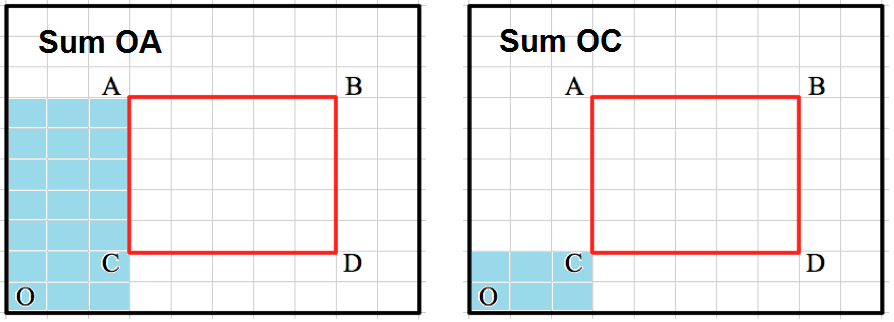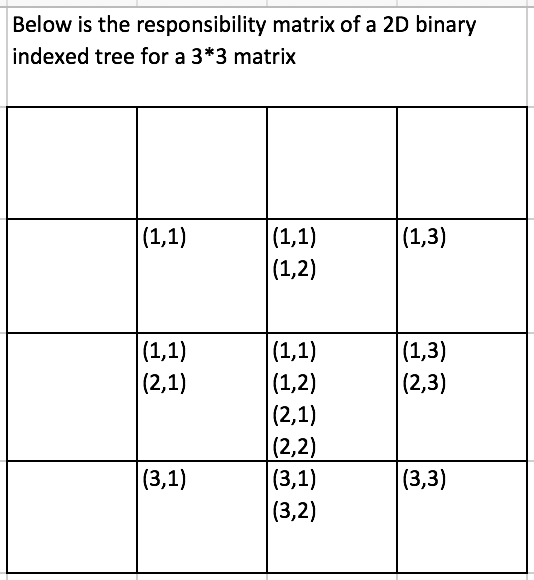Binary Indexed Tree
https://www.youtube.com/watch?v=v_wj_mOAlig
- Binary Indexed Tree require linear memory space.
- Binary Indexed Trees are very easy to code.
- You can use it as an n-dimensional data structure.
Storing the cumulative sum of all the values including that node and its left subtree. For example, given our values, we would store the following:
Before:
[ +5] [ +1] [+15] [+11] [+52] [+28] [ +0]
1 2 3 4 5 6 7
After:
4
[+32]
/ \
2 6
[ +6] [+80]
/ \ / \
1 3 5 7
[ +5] [+15] [+52] [ +0]
If we convert from this to a binary indexed tree, we can observe that the subtraction / add of the last set bit of current index is essentially following the right left or right child/parent links. (for update and query)
There are at most logn nodes to deal with, so it is O(logn) for both update and query.
100
[+37]
/ \
010 110
[+11] [+80]
/ \ / \
001 011 101 111
[+10] [+15] [+52] [ +0]
To find the last set bit: x & (-x)
Intuition:
Say x = a1b(in binary) is the number whose last set bit we want to isolate.
-x= 2’s complement of x =(a1b)’+ 1 =a’0b’+ 1 =a’0(0….0)’ + 1=a’0(1...1) + 1=a’1(0…0)=a’1b

2-dimensional Binary Index Tree Example
308. Range Sum Query 2D - Mutable
The same algorithm is still working fine but with some changes.
The sum should be computed as below:

Sum under the marked area = Sum(OB) - Sum(OD) - Sum(OA) + Sum(OC)
For example, to get sumRegion(1,1) to (3,3) = (3,3) + (3,2) + (2,3) + (2,2)

public class NumMatrix {
int[][] tree;
int[][] nums;
int m, n;
public NumMatrix(int[][] matrix) {
if(matrix==null || matrix.length==0 || matrix[0].length==0) return;
m = matrix.length;
n = matrix[0].length;
tree = new int[m+1][n+1];
nums = new int[m][n];
for (int i=0; i<m; i++) {
for(int j=0; j<n; j++) {
update(i, j, matrix[i][j]);
}
}
}
public void update(int row, int col, int val) {
int delta = val - nums[row][col];
nums[row][col] = val;
for(int i=row+1; i<=m; i+=i&(-i)) { //since it is base 1 arrary
for(int j=col+1; j<=n; j+=j&(-j)) {
tree[i][j] += delta;
}
}
}
public int sumRegion(int row1, int col1, int row2, int col2) {
//because of base 1 arrary of tree[][]
return sum(row2+1, col2+1) - sum(row1, col2+1) - sum(row2+1, col1) + sum(row1, col1);
}
public int sum(int row, int col) {
int sum = 0;
for(int i=row; i>0; i-=i&(-i)) { //since it is base 1 arrary
for(int j=col; j>0; j-=j&(-j)) {
sum += tree[i][j];
}
}
return sum;
}
// time should be O(log(m) * log(n))
}
A more realistic solution during interview...
Though the run time split is update: O(m), query O(n) which is not as good as O(logm*logn) in BIT case.
public class NumMatrix {
private int[][] colSum;
private int[][] matrix;
public NumMatrix(int[][] matrix) {
if(matrix==null || matrix.length<1 || matrix[0].length<1) return;
int m = matrix.length, n = matrix[0].length;
this.matrix = matrix;
//calculate column sum
colSum = new int[m+1][n];
for(int i=1; i<=m; i++) {
for(int j=0; j<n; j++) {
colSum[i][j] = colSum[i-1][j] + matrix[i-1][j];
}
}
}
//worst case is O(m) that we update all the row
public void update(int row, int col, int val) {
for(int i=row+1; i<colSum.length; i++) {
colSum[i][col] = colSum[i][col] - matrix[row][col] + val;
}
matrix[row][col] = val;
}
//worst case is O(n) that we need to iterate through all columns
public int sumRegion(int row1, int col1, int row2, int col2) {
int sum = 0;
for(int j=col1; j<=col2; j++) {
sum += colSum[row2+1][j] - colSum[row1][j];
}
return sum;
}
}